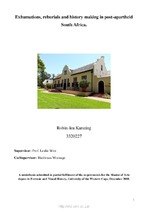| dc.description.abstract | This mini-thesis, ‘Exhumation, Reburial and History Making in South Africa’, is concerned with an analysis of the practices of exhumation and reburial through discussing the case studies of the Iron-Age archaeological site of Mapungubwe, the Vergelegen Wine Estate in Somerset West and the reburials carried out by the Missing Persons Task Team (MPPT) from the National Prosecuting Authority (NPA), particularly its unsuccessful attempt at exhumations at the Stikland Cemetery, in an attempt to understand how they form part of the production of history. These case studies conceive of the times of the precolonial, slavery and apartheid, and are all linked temporally to an envisaged future through ideas of nation building and nationalism. As narratives produced through these exhumations and reburials, they contribute to the notion of making the post-apartheid by remaking history and reconstituting nation. Each of these case studies are significant as they in some way have been utilized in a manner that is relevant to us in the new democratic South Africa.
This mini-thesis aims at rethinking the role of archaeologists, the exhumation and reburial processes, the construction of ethnicity, how the dead are used to construct narratives of struggle against apartheid and in general the implications each of these have on the re-making of history. It also thinks about what the practices of exhumation and reburial mean conceptually and how they relate to the concept of missingness, which I refer to as the process of making absence or invisibility. Thinking about exhumations and reburial in this way has allowed reflection on the purpose of the practices, in terms of who it’s for and how it’s perceived by the stakeholders involved in each case. Through dissecting each of these issues one may be able to trace how the remains to be reburied become missing. Therefore, the question of exhumation and reburial is essential in thinking about what it does for the human remains and how their identity is either shaped or lost. This thesis mainly argues that the remains in each of the case studies go through various phases of missingness and that their reburials and memorialization, or in the case of Stikland the spiritual repatriation, inscribes them further into narratives of the times that they emerged from. | en_US |

